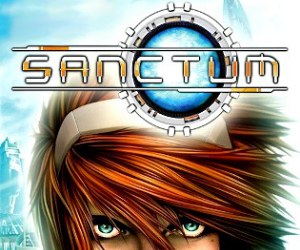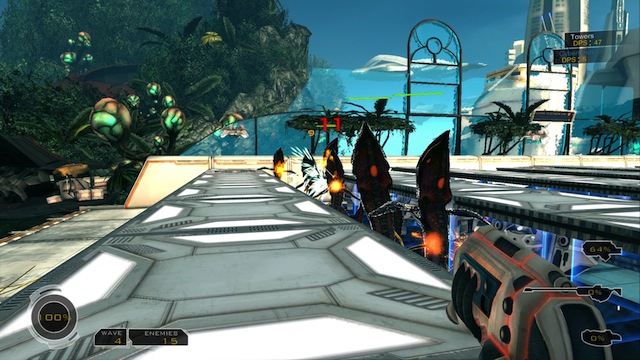Sanctum Collection Review
 Game: Sanctum Collection
Game: Sanctum Collection
Developer: Coffee Stain Studios
Publisher: Coffee Stain Studios
Available on: Windows PC Only
When it comes to Tower Defence games, a lot of us will feel like we’ve played them all before. We’ve all sat there and played them, whether they’re on the iPad, the iPhone, an Android device or just the good old fashioned Personal Computer. Can there really be anything else developers can squeeze out of a genre that’s so tried and tested? Is it as good as it can get with the likes of Spice Invaders and the upcoming DOTA 2? Coffee Stain Studios certainly don’t think so and March of last year saw the release of Sanctum, a FPS Tower Defence game (yes, you read the right) where all of the same tactics that you’ve developed over the years playing “normal” Tower Defence games will still apply; only this time you’re in a first person viewpoint. Does is make it any better though? What about making it worse?
STORY: Throughout the game the players will take control of Skye, an elite soldier who has been given the often difficult task of protecting her home town of Elysion One. In order to do this Skye must construct towers between the oncoming hordes of enemies and the core, which is the goal that you’re meant to protect.

The story isn’t the best in the world and a lot of the time it can be difficult to even understand why you’re doing what you’re doing, but that’s not the point of a Tower Defence game, it never has been. With the odd few exceptions, Tower Defence games have always been more about the gameplay than any story the developer may have tacked onto it. The story in Sanctum does as well as any other game in the genre but don’t expect storytelling on the level of Shakespeare; you’re simply not going to get it.
GRAPHICS: Sanctum uses the Unreal 3 Engine so you can pretty much guarantee that you’re going to get something that looks relatively visually pleasing. When it comes to the enemies that you’ll be facing off against during your time with the game you could look at it from two ends of the spectrum. There are 10 enemies, and for a Tower Defence game that’s not a bad number. It gives the player the opportunity to learn which types of enemies do what and allows them to be able to create a good enough defence to stop them getting to the core. On the other hand is the First Person Shooter aspect, where 10 enemies is nowhere near what we’re used to getting. A lot of people may find themselves getting a little bit bored with the same enemies cropping up all the time. It’s to be expected, considering that Sanctum is at heart a Tower Defence game, but it doesn’t stop it being a little disappointing and more than a little bland.
SOUND: The sound design in Sanctum is something that’s difficult to notice at first, with everything that’s going on in the level at the same time, and all the things that the player is expected to do in order to protect the core, it’s easy to miss the impressive music that’s going on underneath all of it. Thankfully, if you buy the Sanctum Collection, you get an extra CD in the box that contains all of the music in the game. Well worth a listen if you like video game music.
The sound effects that are used in the game are also very well presented, the only time that I found them annoying was when Skye kept shouting “Wooo!” every time I made an impressive headshot, or one of the turrets took down a particularly difficult enemy. This doesn’t happen too often though (I may think I’m good at video games, but I’m not that good) so it didn’t get to the point where it stopped me playing; just something that when it did happen, I cringed a little.

GAMEPLAY: As you would expect from a Tower Defence game, the gameplay revolves around defending a base (in this instance a sphere of blue light called the Core) from the ever increasing number of enemies that are hell-bent on destroying it. In order to do this the player must place towers along the path that the enemy will be walking in an attempt to destroy them before they reach their goal. The towers can range from ones that simply do damage to ones that have an effect on the enemy, such as slowing them down. Where the player decides to place the towers will have a direct effect on the outcome of the level, ending when either the last wave of enemies has been destroyed and the Core is still intact, or when the Core is destroyed.
What makes Sanctum different from every other game in the genre is that fact that it’s played from the First Person perspective. There are two phases in the game, the Build Phase, which is where the player runs around the map using the resources they’ve collected during the previous Survival Phase to place towers, blocks, traps and anything else that they can get their hands on in order to stop the next wave of enemies from reaching the Core. The second phase is the aforementioned Survival Phase. This is the phase where the enemy makes their way towards the Core and you get to see just how well you’ve set things up during the Build Phase; set things up well and you’ll survive the phase, set things up wrong however (such as failing to notice that the next wave comprises only of airborne enemies and forgetting to set up some anti-air towers) and you’ll get to watch yourself slowly fail during this phase. Not fun at all.
The two phases can be a little difficult to get a grasp of at first, there’s a lot of things that the player is supposed to remember at the same time, as well as a lot of controls to remember in order to do things that would be simple in a Tower Defence game where half the buttons you’re supposed to remember aren’t for jumping, moving and shooting. Once you get the buttons under control however, things will start to feel fluid and you’ll begin to wonder why you ever had a problem with them at all.

The other aspect of the game, during the Survival Phase, is an all out First Person Shooter. As well as being able to place towers into the game world in order to take down your enemies, you can also help them out by grabbing your trusty weapons and shooting all those enemies in the face. You won’t be doing as much damage as the towers (they are the main point of the game after all) but some enemies actively require you to be at least a little proficient with the weaponry you’re given. The tanks – for example – have a shield on them that, unless it’s disabled by the player shooting them in their weak spot, will absorb most of the damage that the towers are dealing out, making the whole wave a whole lot harder.
LONGEVITY: As with any game of this genre, how long it last depends entirely on how much time you’re wanting to put into it. A player could easily just play the game until the end of the levels, playing through all of the DLC that comes packaged with the Sanctum Collection box, and then never touch the game again. If you’re the type of player who cares about high scores though, you’ll be playing Sanctum for a long time to come, trying to beat your high score, your friends high score and even random people around the world’s high score. There are multiple ways to finish each of the levels and a lot of the fun comes from figuring out the most efficient way of dispatching all of the enemies. Add to that the multiplayer mode, allowing players to help each other to overcome the oncoming hordes, and you’ve got a game that has the potential to be played for a good long while.
VERDICT: If you’re a fan of Tower Defence games and you’ve been looking for something that’s a little bit different, then Sanctum is the game for you. It successfully takes the good parts of a classic Tower Defence game and merges them with the impressive graphics and feeling of involvement that you get from the First Person viewpoint. Sanctum is an under-appreciated gem in a world that’s flooded with mediocrity. Even if you’ve had a bad time with this genre before you should at least give it a go; you never know, a slight change in normality might be just what you’ve been looking for.






